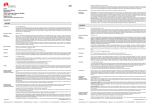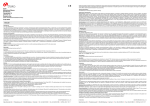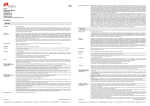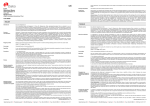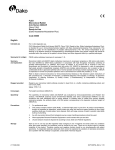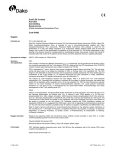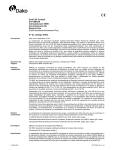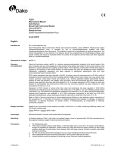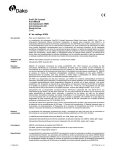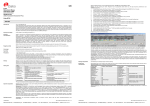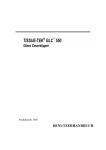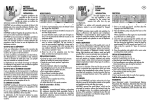Download DuoFLEX Cocktail Anti-AMACR Anti-Cytokeratin HMW Anti
Transcript
DuoFLEX Cocktail Anti-AMACR Anti-Cytokeratin HMW Anti-Cytokeratin 5/6 Ready-to-Use (Dako Autostainer/Autostainer Plus) Code IK004 English Intended use For in vitro diagnostic use. DuoFLEX Cocktail Monoclonal Rabbit Anti-Human AMACR, Clone 13H4, Monoclonal Mouse Anti-Human Cytokeratin, High Molecular Weight, Clone 34ßE12 and Monoclonal Mouse Anti-Human Cytokeratin 5/6, Clone D5/16 B4 (Dako Autostainer/Autostainer Plus), is intended for use in immunohistochemistry together with Dako Autostainer/Autostainer Plus instruments. This antibody cocktail is used as an adjunctive diagnostic test for the confirmation of prostatic carcinoma, prostatic intraepithelial neoplasia, and its benign mimic lesions in formalinfixed, paraffin-embedded prostate tissues (1-5) after the primary diagnosis is made by morphological examination of H&E stained slides. The clinical interpretation of any staining or its absence should be complemented by morphological studies using proper controls and should be evaluated within the context of the patient’s clinical history and other diagnostic tests by a qualified pathologist. Synonyms for antigen AMACR: Alpha methylacyl Coenzyme A racemase, α-Methylacyl-CoA, P504S Cytokeratin HMW: Keratin 903 Summary and explanation AMACR: Monoclonal rabbit anti-AMACR, Clone 13H4 recognizes a 382 amino acid protein that was identified by cDNA library subtraction in conjunction with high throughput microarray screening of prostate adenocarcinoma (6). Alpha-methylacyl-CoA racemase (AMACR) is an enzyme that is involved in bile acid biosynthesis and β-oxidation of branched-chain fatty acids (7). AMACR is expressed in cells of premalignant high grade prostatic intraepithelial neoplasia (HGPIN) and prostate adenocarcinoma, but is present at low or undetectable levels in glandular epithelial cells of normal prostate and benign prostatic hyperplasia (6,8-13). CK HMW: Cytokeratins are intermediate filament cytoskeletal proteins essential to development and differentiation of epithelial cells. Approximately twenty different cytokeratins have been identified and are classified and numbered according to molecular weight and isoelectric points (14). In general, most low molecular weight cytokeratins (40-54 kDa) are distributed in nonsquamous epithelium, Moll’s catalog numbers 7-8 and/or 17-20 (15). High molecular weight cytokeratins (48-67 kDa) are found in the squamous epithelium, Moll’s catalog numbers 1-6 and/or 9-16 (15). Cytokeratin 5/6: Monoclonal Mouse Anti-Human Cytokeratin 5/6, Clone D5/16 B4 is a high molecular weight, basic type of cytokeratin, with a molecular mass of 58 kDa, expressed in the basal, the intermediate and the superficial cell layers of stratified epithelia as well as in transitional epithelia, complex epithelia, and in mesothelial cells and mesothelioma. CK 5 has not, with few exceptions, been found in simple epithelia and in non-epithelial cells. CK 6 is also a high molecular weight, basic type of cytokeratin, with a molecular mass of 56 kDa, expressed by proliferating squamous epithelium often paired with CK 16 (48 kDa) (16,17). Refer to Dako’s General Instructions for Immunohistochemical Staining or the detection system instructions of IHC procedures for: 1) Principle of Procedure, 2) Materials Required, Not Supplied, 3) Storage, 4) Specimen Preparation, 5) Staining Procedure, 6) Quality Control, 7) Troubleshooting, 8) Interpretation of Staining, 9) General Limitations. Reagent provided Ready-to-Use monoclonal rabbit and monoclonal mouse antibody cocktail provided in liquid form in a buffer containing stabilizing protein and 0.015 mol/L NaN3. Monoclonal Rabbit Anti-Human AMACR, Clone 13H4, Isotype: IgG1, kappa Monoclonal Mouse Anti-Human Cytokeratin, High Molecular Weight, Clone 34ßE12, Isotype: IgG1, kappa Monoclonal Mouse Anti-Human Cytokeratin 5/6, Clone D5/16 B4, Isotype: IgG1, kappa Immunogen AMACR: Full length recombinant P504S (6) CK HMW: solubilized immunogen keratin extracted from human stratum corneum Cytokeratin 5/6: Isolated cytokeratin 5 Specificity The specificity of monoclonal rabbit anti-AMACR was evaluated by immunocytochemistry and Western blot analysis. Anti-AMACR positively bound formalin-fixed HEK293 cells which overexpressed AMACR, but was unreactive with cells transfected with an empty plasmid. In Western blots of lysates from primary prostate carcinoma samples, monoclonal rabbit anti-AMACR identified a 54 kDa protein which is consistent with the expected molecular weight of AMACR (9). (119829-001) 307773EFG_001 p. 1/13 Anti-CK HMW, 34βE12 has been shown to react with the 66, 57, 51 and 49 kDa (1) proteins corresponding to cytokeratins 1, 5, 10 and 14 of the Moll catalog (14,15,18). Shah et al. (19) suggested clinical usefulness of anti-CK HMW, 34ßE12 as an aid in the differentiation of Paget’s disease and Bowen’s disease (carcinoma in situ) from Pagetoid superficial spreading melanoma. Anti-CK HMW, 34βE12 positivity was reported in Paget’s disease of the breast (5/5) and Bowen’s disease (10/10), although 25% (1/4) of Paget’s disease of the vulva and 0/6 of the Pagetoid superficial spreading melanomas stained (19). For Anti-Cytokeratin 5/6, Clone D5/16 B4, in Western blotting of cytoskeletal preparations of epidermis and nonkeratinizing epithelium, the antibody labels cytokeratin 5. It also labels cytokeratin 6 and weakly labels cytokeratin 4. No cross-reaction with cytokeratins 1, 7, 8, 10, 13/14, 18 and 19 has been found. Precautions 1. For professional users. 2. This product contains sodium azide (NaN3), a chemical highly toxic in pure form. At product concentrations, though not classified as hazardous, sodium azide may react with lead and copper plumbing to form highly explosive build-ups of metal azides. Upon disposal, flush with large volumes of water to prevent metal azide build-up in plumbing. 3. As with any product derived from biological sources, proper handling procedures should be used. 4. Wear appropriate Personal Protective Equipment to avoid contact with eyes and skin. 5. Unused solution should be disposed of according to local, State and Federal regulations. Storage Store at 2–8 °C. Do not use after expiration date s tamped on vial. If reagents are stored under any conditions other than those specified, the conditions must be verified by the user. There are no obvious signs to indicate instability of this product. Therefore, positive and negative controls should be run simultaneously with patient specimens. If unexpected staining is observed which cannot be explained by variations in laboratory procedures and a problem with the antibody is suspected, contact Dako Technical Support. Specimen preparation including materials required but not supplied The antibody cocktail can be used for labeling formalin-fixed, paraffin-embedded tissue sections. Tissue specimens should be cut into sections of approximately 4 µm. Pre-treatment with heat-induced epitope retrieval (HIER) is required. Optimal results are obtained by pretreating tissues using EnVision FLEX Target Retrieval Solution, High pH (50x) (Code K8004). Deparaffinized sections: Pre-treatment of deparaffinized formalin-fixed, paraffin-embedded tissue sections is recommended using Dako PT Link (Code PT100/PT101). For details, please refer to the PT Link User Guide. Follow the pre-treatment procedure outlined in the package insert for EnVision FLEX Target Retrieval Solution, High pH (50x) (Code K8004). The following parameters should be used for PT Link: Pre-heat temperature: 65 °C; epitope retrieval temperature and time: 97 °C for 2 0 (±1) minutes; cool down to 65 °C. Remove Autostai ner slide rack with slides from the PT Link tank and immediately dip slides into a jar/tank (e.g., PT Link Rinse Station, Code PT109) containing diluted room temperature EnVision FLEX Wash Buffer (20x) (Code K8007). Leave slides in Wash Buffer for 1-5 minutes. Paraffin-embedded sections: Using aqueous mounting medium (Dako Faramount Code S3025) is the preferred coverslipping method. As alternative specimen preparation, both deparaffinization and epitope retrieval can be performed in the PT Link using a modified procedure. See the PT Link User Guide for instructions. After the staining procedure has been completed, the sections must be air dried at 60 °C, immersed in xylene and mounted using permanent mounting medium. Alcohol should be avoided with permanent mounting as it may diminish reactivity of the red chromogen. Before mounting, the tissue sections should not dry out during the pre-treatment or during the following immunohistochemical staining procedure. For greater adherence of tissue sections to glass slides, the use of Dako FLEX IHC Microscope Slides (Code K8020) is recommended. Staining procedure including materials required but not supplied The recommended visualization system is EnVision DuoFLEX Doublestain System, (Dako Autostainer/Autostainer Plus) (Code K6807). The staining steps and incubation times are pre-programmed into the software of Dako Autostainer/Autostainer Plus instruments, using the following protocols: Template protocol: DuoFLEX2 (200 µL dispense volume) or DuoFLEX3 (300 µL dispense volume) Autoprogram: PINct (without counterstaining) or PINcth (with counterstaining) All incubation steps should be performed at room temperature. For details, please refer to the Operator’s Manual for the dedicated instrument. If the protocols are not available on the used Dako Autostainer instrument, please contact Dako Technical Services. Optimal conditions may vary depending on specimen and preparation methods, and should be determined by each individual laboratory. If the evaluating pathologist should desire a different staining intensity, a Dako Application Specialist/Technical Service Specialist can be contacted for information on re-programming of the protocol. Verify that the performance of the adjusted protocol is still valid by evaluating that the staining pattern is identical to the staining pattern described in “Performance characteristics”. Counterstaining in hematoxylin is recommended using EnVision FLEX Hematoxylin, (Dako Autostainer/Autostainer Plus) (Code K8018). After the staining procedure has been completed, the sections must be air dried, immersed in xylene and mounted using permanent mounting medium. Alcohol should be avoided with permanent mounting as it may diminish reactivity of the red chromogen. Positive and negative controls should be run simultaneously using the same protocol as the patient specimens. The positive control tissue should include Prostate (normal or hyperplasia) and the cells/structures should display reaction patterns as described for this tissue in “Performance characteristics” in all positive specimens. (119829-001) 307773EFG_001 p. 2/13 Staining interpretation Carcinoma cells labeled by Anti-AMACR display red granular cytoplasmic staining. Cells labeled by Anti-Cytokeratin High Molecular weight display brown cytoplasmic staining. Cells labeled by Anti-Cytokeratin 5/6 display brown cytoplasmic staining. Performance characteristics Normal tissues: Anti-AMACR: Tissue Type (# Tested) (8,9,12) Kidney (12)8 Liver (15)8 Lung (12)8 Gallbladder (10)8 Colon (20)9 Hyperplastic colon (28)12 Prostate, benign (194)9 Adrenal (12)8 Bladder (7)8 Brain (5)8 Breast (12)8 Endometrium (12)8 Heart (5)8 Lymph Node (7)8 Pancreas (15)8 Prostate (19)8 Ovary (12)8 Small Intestine (18)8 Salivary gland (7)8 Skin (7)8 Spleen (12)8 Stomach (13)8 Thyroid (5)8 Testes (5)8 Positively Staining Tissue Elements 12/12 Tubular epithelial cells 15/15 Hepatocytes 12/12 Bronchial epithelial cells 10/10 Epithelial cells 20/20 colonic surface epithelium, focal and luminal 1/28 23/194 0/12 0/7 0/5 0/12 0/12 0/5 0/7 0/15 0/19 0/12 0/18 0/7 0/7 0/12 0/13 0/5 0/5 Anti-CK HMW, 34βE12 is reactive with normal epithelial tissues which include: squamous epithelium and sweat ducts in skin (18), all epithelial layers including luminal and basal epithelium and ductal cells in breast (20), some pneumocytes, mesothelium and bronchial epithelium in lung, collecting duct epithelia in kidney and ductal cells in the pancreas, bile ducts in the liver, and mesothelium and a portion of epithelium (cells with a more basal location) of the gastrointestinal tract (18). Hepatocytes, pancreatic acinar cells, proximal renal tubules and nonepithelial normal tissues are not labeled by anti-CK HMW, 34βE12 (18). Anti-CK HMW, 34βE12 stained mammary gland of the breast, squamous epithelia of the cervix, prostate gland, excretory duct of the lingual salivary gland, squamous epithelia of the skin, reticular cells and Hassall’s bodies of the thymus, and squamous epithelium of the tonsil. No staining was demonstrated on adrenal, bone marrow, brain cerebellum or cerebrum, colon, heart, kidney, liver, lung, mesothelial cells, ovary, pancreas, parathyroid, pericardium, peripheral nerve, pituitary, skeletal muscle, small intestine, spleen, stomach, testis, thyroid or uterus. The Cytokeratin 5/6 antibody labels stratified squamous epithelia. In complex epithelia, the basal cells in most cases express CK 5. Simple epithelia and non-epithelial cells, generally, are not labeled by the antibody. Abnormal Tissues: Anti-AMACR is immunoreactive with the majority of prostate carcinomas tested (8-13). Tissue Type (# Tested) Prostate adenocarcinoma (18)8 Hepatocellular carcinoma (21)8 Kidney carcinoma (24)8 Bladder transitional cell carcinoma (29)8 Stomach adenocarcinoma (15)8 Breast adenocarcinoma (61)8 Bile duct cholangiocarcinoma (14)8 Lung adenocarcinoma (23)8 Neuroendocrine carcinoma; GI, lung and liver (9)8 Soft tissue epithelioid sarcoma (12)8 Ovary adenocarcinoma (27)8 Pancreas adenocarcinoma (13)8 Adrenal cortical tumor (20)8 Salivary gland tumors (28)8 Colon Carcinomas (176)12 Well differentiated (58)12 Moderately differentiated (88)12 Poorly differentiated (30)12 (119829-001) Positively Staining Tumors 17/18 17/21 18/24 9/29 4/15 9/61 2/14 3/23 1/9 1/12 2/27 1/13 1/20 1/28 122/176 45/58 66/88 11/30 307773EFG_001 p. 3/13 Germ cell tumors (14)8 Carcinoid tumors; lung and GI (10)8 Small cell carcinoma; lung and skin (15)8 Pleural mesothelioma (16)8 Undifferentiated carcinoma (27)8 Melanoma (20)8 Squamous cell carcinoma; skin and mucosa (25)8 Basal cell carcinoma of skin (20)8 Synovial sarcoma (6)8 Thyroid tumors (54)8 Thymoma (8)8 Endometrioid carcinoma (10)8 0/14 0/10 0/15 0/16 0/27 0/20 0/25 0/20 0/6 0/54 0/8 0/10 The anti-CK HMW, 34βE12 antibody positivity has been reported for squamous cell and ductal or transitional cell carcinomas including: squamous cell carcinoma of the skin, lung and nasopharynx, ductal carcinoma of the breast, pancreas, bile duct and salivary gland as well as transitional cell carcinomas of the bladder and nasopharynx and thymomas (21,22). Anti-CK HMW, 34βE12 stained epithelial mesotheliomas, but failed to react with sarcomatoid or desmoplastic mesotheliomas (23). Anti-CK HMW, 34βE12-negative epithelial tumors are either “acinar” type adenomas (e.g., pituitary) or adenocarcinomas of simple epithelia (e.g., endometrial carcinomas, renal and hepatocellular carcinomas) or neuroendocrine tumors (18,22,24). Thus, anti-CK HMW, 34βE12 may be used as an aid in the subclassification of carcinomas (22). It has been suggested also that antiCK HMW, 34βE12 is useful in the differential diagnosis of small acinar lesions of the prostate gland (11). Its diagnostic value may lie in the identification of basal cells. O’Malley et al. (25) saw positive staining of basal cells in 47 examples of benign prostatic lesions including atypical adenomatous hyperplasia (26), basal cell hyperplasia (21), atrophy (20), post-sclerotic hyperplasia (19) and fibroepithelial nodule (14), while 21 cases of small-acinar adenocarcinomas showed no reactivity. It was stressed that loss of basal cell layer is not uniform in all prostatic adenocarcinomas. Basal cells are lost only in small-acinar adenocarcinomas. It was recommended that complete absence of staining of prostate lesions with anti-CK HMW, 34βE12 should be regarded as very suggestive, but not diagnostic of malignancy. The Cytokeratin 5/6 antibody labeled 56/61 (92%) of epithelioid pleural mesotheliomas, while 9/63 (14%) of metastatic adenocarcinomas were labeled. Reactive mesothelium was also labeled (27). In another study (28), all of 23 mesotheliomas with epithelioid or acinar differentiation were strongly labeled by the antibody, while labeling in the sarcomatoid areas of tumors with a mixed morphology was weak or absent. One case of sarcomatoid mesothelioma gave an equivocal reaction, whereas mesotheliomas of desmoplastic or sarcomatoid type were negative. Of 27 secondary adenocarcinomas of the pleura, 22 were negative, 4 weak or equivocal, and 1 focally positive. High levels of cytokeratin 5/6 positivity in ductal hyperplasia of usual type, and negative staining of most cases of atypical ductal hyperplasia and ductal carcinoma in situ, have been demonstrated with the antibody (29). Français Réf. IK004 Utilisation prévue Pour utilisation diagnostique in vitro. Le cocktail DuoFLEX constitué d'anticorps monoclonal de lapin anti-AMACR humain, clone 13H4, d'anticorps monoclonal de souris anti-cytokératine humaine, de poids moléculaire élevé, clone 34ßE12 et d'anticorps monoclonal de souris anti-cytokératine humaine 5/6, clone D5/16 B4 (Dako Autostainer/Autostainer Plus), est destiné à être utilisé en immunohistochimie avec les instruments Dako Autostainer/Autostainer Plus. Ce cocktail d'anticorps est utilisé comme test de diagnostic complémentaire pour confirmer un carcinome ou une néoplasie intraépithéliale de la prostate, et les lésions mimétiques bénignes sur des coupes tissulaires de la prostate, fixées au formol et incluse en paraffine (1-5) après un premier diagnostic établi par examen morphologique de lames colorées à l'hématoxyline et à l'éosine. L’interprétation clinique de toute coloration ou son absence doit être complétée par des études morphologiques en utilisant des contrôles appropriés et doit être évaluée en fonction des antécédents cliniques du patient et d’autres tests diagnostiques par un pathologiste qualifié. Synonymes de l’antigène AMACR : Alpha méthylacyl coenzyme A racémase, α-Méthylacyl-CoA, P504S CytokératineHMW : kératine 903 Résumé et explication AMACR : l’anticorps monoclonal de lapin anti-AMACR, clone 13H4, reconnaît une protéine de 382 acides aminés qui a été identifiée par soustraction d’une banque d’ADNc en association avec un dépistage à haut débit sur biopuce de l’adénocarcinome de la prostate (6). L'alpha méthylacyl coenzyme A racémase (AMACR) est une enzyme impliquée dans la biosynthèse des acides biliaires et la β–oxydation des acides gras à chaîne ramifiée (7). L'AMACR est exprimée dans des cellules issues d’une néoplasie intraépithéliale prostatique de haut grade (HGPIN) prémaligne et d’un adénocarcinome de la prostate, mais est présente à des taux faibles ou indétectables dans les cellules épithéliales glandulaires de la prostate saine et dans l’hyperplasie prostatique bénigne (6, 8-13). CK HMW : les cytokératines sont des protéines du filament intermédiaire du cytosquelette essentielles au développement et à la différenciation des cellules épithéliales. Environ vingt cytokératines différentes ont été identifiées. Elles sont classées et numérotées en fonction de leur poids moléculaire et de leur point isoélectrique (14). En général, la plupart des cytokératines de faible poids moléculaire (entre 40 et 54 kDa) sont réparties dans (119829-001) 307773EFG_001 p. 4/13 l’épithélium non squameux, et correspondent aux numéros 7-8 et/ou 17-20 de la classification de Moll (15). Les cytokératines de poids moléculaire élevé (entre 48 et 67 kDa) se situent dans l’épithélium pavimenteux, et correspondent aux numéros 1-6 et/ou 9-16 de la classification de Moll (15). Cytokératine 5/6 : l'anticorps monoclonal de souris anti-cytokératine humaine 5/6, clone D5/16 B4, est un type basique de cytokératine de poids moléculaire élevé, avec une masse moléculaire de 58 kDa, exprimée dans les couches basales, intermédiaires et superficielles des épithéliums stratifiés ainsi que des épithéliums transitionnels, des épithéliums complexes, des cellules mésothéliales et des mésothéliomes. La CK 5 n’est pas, à quelques rares exceptions, présente dans les épithéliums simples et dans les cellules non épithéliales. La CK 6 est également un type basique de cytokératine de poids moléculaire élevé, avec une masse moléculaire de 56 kDa, exprimée par l'épithélium pavimenteux prolifératif souvent associé à la CK 16 (48 kDa) (16,17). Se reporter aux « Instructions générales de coloration immunohistochimique » de Dako ou aux instructions du système de détection relatives aux procédures d'IHC pour plus d’informations concernant les points suivants : 1) Principe de procédure, 2) Matériels requis mais non fournis, 3) Conservation, 4) Préparation des échantillon, 5) Procédure de coloration, 6) Contrôle qualité, 7) Dépannage, 8) Interprétation de la coloration, 9) Limites générales. Réactifs fournis Cocktail d'anticorps polyclonal de lapin et monoclonal de souris prêt à l’emploi fourni sous forme liquide dans un tampon contenant une protéine stabilisante et 0,015 mol/L d’azide de sodium (NaN3). Anticorps monoclonal de lapin anti-AMACR humaine, clone 13H4, Isotype : IgG1, kappa Anticorps monoclonal de souris anti-cytokératine humaine, de poids moléculaire élevé, clone 34ßE12, Isotype : IgG1, kappa Anticorps monoclonal de souris anti-cytokératine humaine 5/6, clone D5/16 B4, Isotype : IgG1, kappa Immunogène AMACR : P504S recombinante de pleine longueur (6) CK HMW : kératine immunogène soluble extraite de la couche cornée de l'épiderme humain Cytokératine 5/6 : cytokératine 5 isolée Spécificité La spécificité de l’anticorps monoclonal de lapin anti-AMACR a été évaluée par immunocytochimie et par Western blot. L’anticorps anti-AMACR s’est lié de façon positive aux cellules HEK293 fixées au formol qui surexprimaient l'AMACR mais n’a pas interagi avec les cellules transfectées avec un plasmide vide. Dans les analyses par Western blot de lysats issus d’échantillons de carcinome primitif de la prostate, l’anticorps monoclonal de lapin anti-AMACR a identifié une protéine de 54 kDa qui est compatible avec le poids moléculaire de l'AMACR (9). L’anticorps anti-CK HMW, 34βE12 a démontré qu’il réagissait avec les protéines de 66, 57, 51 et 49 kDa (1) correspondant aux cytokératines 1, 5, 10 et 14 de la classification de Moll (14, 15, 18). Shah et al. (19) ont suggéré que l’anticorps anti-CK HMW, 34ßE12 pouvait permettre de différencier la maladie de Paget et la maladie de Bowen (carcinome in situ) d’une part et le mélanome à extension superficielle pagetoïde d’autre part. La positivité de l'anticorps anti-CK HMW, 34βE12 a été signalée dans la maladie de Paget du sein (5 cas sur 5) et dans la maladie de Bowen (10 cas sur 10), bien qu’une coloration ait été signalée dans 25 % des cas (1 sur 4) de maladie de Paget de la vulve et dans aucun des 6 cas de mélanome à extension superficielle pagetoïde (19). Lors d’analyses par Western blot de préparations cytosquelettiques d’épiderme et d’épithélium non kératinisant, l’anticorps anti-cytokératine 5/6, clone D5/16 B4, marque la cytokératine 5. Il marque également la cytokératine 6 et marque faiblement la cytokératine 4. Aucune réaction croisée avec les cytokératines 1, 7, 8, 10, 13/14, 18 et 19 n’a été constatée. Précautions 1. Pour utilisateurs professionnels. 2. Ce produit contient de l’azide de sodium (NaN3), produit chimique hautement toxique dans sa forme pure. Aux concentrations du produit, bien que non classé comme dangereux, l’azide de sodium peut réagir avec le cuivre et le plomb des canalisations et former des accumulations d’azides métalliques hautement explosives. Lors de l’élimination, rincer abondamment à l’eau pour éviter toute accumulation d’azide métallique dans les canalisations. 3. Comme avec tout produit d’origine biologique, respecter les procédures de manipulation appropriées. 4. Porter un équipement de protection approprié pour éviter le contact avec les yeux et la peau. 5. Les solutions non utilisées doivent être éliminées conformément aux réglementations locales et nationales. Conservation Conserver entre 2 et 8 °C. Ne pas utiliser après la date limite de péremption indiquée sur le flacon. Si les réactifs sont conservés dans des conditions autres que celles indiquées, celles-ci doivent être validées par l’utilisateur. Il n’y a aucun signe évident indiquant l’instabilité de ce produit. Par conséquent, des contrôles positifs et négatifs doivent être testés en même temps que les échantillons de patients. Si une coloration inattendue est observée, qui ne peut être expliquée par un changement des procédures du laboratoire, et en cas de suspicion d’un problème lié à l’anticorps, contacter l’assistance technique de Dako. Préparation des échantillons y compris le matériel requis mais non fourni L’anticorps peut être utilisé pour le marquage des coupes tissulaires incluses en paraffine et fixées au formol. L’épaisseur des coupes d’échantillons de tissu doit être d’environ 4 µm. (119829-001) Le prétraitement avec un démasquage d’épitope induit par la chaleur (HIER) est nécessaire. Des résultats optimaux sont obtenus en prétraitant les tissus à l’aide de la EnVision FLEX Target Retrieval Solution, High pH (50x), (Réf. K8004). 307773EFG_001 p. 5/13 Coupes déparaffinées : le prétraitement des coupes tissulaires fixées au formol et incluses en paraffine puis déparaffinées est recommandé à l’aide du Dako PT Link (Réf. PT100/PT101). Pour plus de détails, se référer au Guide d’utilisation du PT Link. Suivre la procédure de prétraitement indiquée dans la notice pour la EnVision FLEX Target Retrieval Solution, High pH (50x), (Réf. K8004). Les paramètres suivants doivent être utilisés pour le PT Link : température de préchauffage : 65 °C ; température et durée du déma squage d’épitope : 97 °C pendant 20 (±1) minutes ; refroidissement à 65 °C. Retirer chaque portoir à l ames Autostainer contenant les lames de la cuve du PT Link et plonger immédiatement les lames dans un récipient/une cuve (par ex., PT Link Rinse Station, Réf. PT109) contenant du tampon de lavage EnVision FLEX Wash Buffer (20x), (Réf. K8007), dilué à température ambiante. Laisser les lames dans le tampon de lavage pendant 1 à 5 minutes. Coupes incluses en paraffine : le milieu de montage aqueux (Dako Faramount Réf. S3025) est la méthode privilégiée d'application de lamelles de protection. Comme préparation alternative des échantillons, le déparaffinage et la restauration de l’épitope peuvent être réalisés dans le PT Link à l’aide d’une procédure modifiée. Se référer aux instructions du Guide d’utilisation du PT Link. Une fois la procédure de coloration terminée, les coupes doivent être séchées à l'air à 60 °C, immergées dans du xylène et montées à l’aide d’un milieu de montage permanent. Éviter d'utiliser de l'alcool comme milieu de montage permanent car il peut diminuer la réactivité de la solution chromogène rouge. Avant montage, les coupes tissulaires ne doivent pas sécher lors du prétraitement ni lors de la procédure de coloration immunohistochimique qui suit. Pour une meilleure adhérence des coupes de tissus sur les lames de verre, il est recommandé d’utiliser des lames Dako FLEX IHC Microscope Slides (Réf. K8020). Procédure de coloration y compris le matériel requis mais non fourni Le système de visualisation recommandé est le EnVision DuoFLEX Doublestain System, (Dako Autostainer/Autostainer Plus) (Réf. K6807). Les étapes de coloration et d’incubation sont préprogrammées dans le logiciel des instruments Dako Autostainer/Autostainer Plus, à l’aide des protocoles suivants : Protocole modèle : DuoFLEX2 (volume de distribution 200 µL) ou DuoFLEX3 (volume de distribution 300 µL) Programme automatique : PINct (sans contre-coloration) ou PINcth (avec contre-coloration) Toutes les étapes d’incubation doivent être effectuées à température ambiante. Pour plus de détails, se référer au Manuel de l’opérateur spécifique à l'instrument. Si les protocoles ne sont pas disponibles sur l’instrument Dako Autostainer utilisé, contacter le service technique de Dako. Les conditions optimales peuvent varier en fonction du prélèvement et des méthodes de préparation, et doivent être déterminées par chaque laboratoire individuellement. Si le pathologiste qui réalise l’évaluation désire une intensité de coloration différente, un spécialiste d’application/spécialiste du service technique de Dako peut être contacté pour obtenir des informations sur la reprogrammation du protocole. Vérifier que l'exécution du protocole modifié est toujours valide en vérifiant que le schéma de coloration est identique au schéma de coloration décrit dans les « Caractéristiques de performance ». Il est recommandé d’effectuer une contre-coloration à l’aide d’hématoxyline EnVision FLEX Hematoxylin, (Dako Autostainer/Autostainer Plus) (Réf. K8018). Une fois que la procédure de coloration est terminée, les coupes doivent être doivent être séchées à l'air, immergées dans du xylène à l’aide d’un milieu de montage permanent. Éviter d'utiliser de l'alcool comme milieu de montage permanent car il peut diminuer la réactivité de la solution chromogène rouge. Des contrôles positifs et négatifs doivent être réalisés en même temps et avec le même protocole que les échantillons du patient. Le tissu de contrôle positif doit comprendre la prostate (saine ou hyperplasique) et les cellules/structures doivent présenter les schémas de réaction décrits pour ces tissus à la section « Caractéristiques de performance » pour tous les échantillons positifs. Interprétation de la coloration Les cellules de carcinome marquées par l'anticorps anti-AMACR présentent une coloration cytoplasmique granulaire rouge. Les cellules marquées par l’anticorps anti-cytokératine de poids moléculaire élevé présentent une coloration cytoplasmique brune. Les cellules marquées par l’anticorps anti-cytokératine 5/6 présentent une coloration cytoplasmique brune. Caractéristiques de performance Tissus sains : Anti-AMACR : type de tissus (nombre testé) (8, 9, 12) Rein (12)8 Foie (15)8 Poumon (12)8 Vésicule biliaire (10)8 Côlon (20)9 Côlon hyperplasique (28)12 Prostate, bénigne (194)9 Cortico-surrénale (12)8 Vessie (7)8 Cerveau (5)8 Sein (12)8 Endomètre (12)8 Cœur (5)8 Ganglion lymphatique (7)8 (119829-001) Éléments tissulaires colorés positivement 12/12 cellules épithéliales tubulaires 15/15 hépatocytes 12/12 cellules épithéliales bronchiques 10/10 cellules épithéliales 20/20 épithélium de la surface du côlon, focal et luminal 1/28 23/194 0/12 0/7 0/5 0/12 0/12 0/5 0/7 307773EFG_001 p. 6/13 Pancréas (15)8 Prostate (19)8 Ovaire (12)8 Intestin grêle (18)8 Glande salivaire (7)8 Peau (7)8 Rate (12)8 Estomac (13)8 Thyroïde (5)8 Testicules (5)8 0/15 0/19 0/12 0/18 0/7 0/7 0/12 0/13 0/5 0/5 L'anticorps anti-CK HMW, 34βE12 réagit avec les tissus épithéliaux sains, dont : l’épithélium pavimenteux et les canaux sudoripares de la peau (18), toutes les couches épithéliales notamment l’épithélium luminal et basal ainsi que les cellules canalaires du sein (20), certains pneumocytes, le mésothélium et l’épithélium bronchique du poumon, l'épithélium des canaux collecteurs du rein et les cellules canalaires du pancréas, les canaux biliaires du foie ainsi que le mésothélium et une partie de l’épithélium (cellules situées plutôt dans la couche basale) de l’appareil digestif (18). Les hépatocytes, les cellules acinaires pancréatiques, les tubules rénaux proximaux et les tissus sains non épithéliaux ne sont pas marqués par l’anticorps anti-CK HMW, 34βE12 (18). L’anti-CK HMW, 34βE12 colore la glande mammaire, l’épithélium pavimenteux du col de l’utérus, la prostate, le canal excrétoire de la glande salivaire linguale, l’épithélium pavimenteux cutané, les cellules réticulaires et les corpuscules de Hassall situés dans le thymus ainsi que l’épithélium pavimenteux de l’amygdale. Aucune coloration n’a été relevée sur les tissus suivants : glande surrénale, moelle osseuse, cervelet, côlon, cœur, rein, foie, poumon, cellules mésothéliales, ovaire, pancréas, parathyroïde, péricarde, nerf périphérique, hypophyse, muscle squelettique, intestin grêle, rate, estomac, testicule, thyroïde ou utérus. L'anticorps anti-cytokératine 5/6 marque l'épithélium pavimenteux stratifié. Dans les épithéliums complexes, les cellules basales de la plupart des cas expriment le CK 5. Les cellules simples épithéliales et non épithéliales ne sont en général pas marquées par l'anticorps. Tissus tumoraux : L’anticorps anti-AMACR est immunoréactif avec la majorité des carcinomes de la prostate testés (8-13). Type de tissus (nombre testé) Tumeurs colorées positivement 17/18 17/21 18/24 9/29 4/15 9/61 2/14 3/23 1/9 Adénocarcinome de la prostate (18)8 Carcinome hépatocellulaire (21)8 Carcinome rénal (24)8 Carcinome à cellules transitionnelles de la vessie (29)8 Adénocarcinome de l’estomac (15)8 Adénocarcinome du sein (61)8 Cholangiocarcinome des canaux biliaires (14)8 Adénocarcinome du poumon (23)8 Carcinome neuroendocrinien ; gastro-intestinal, pulmonaire et hépatique (9)8 Sarcome épithélioïde des tissus mous (12)8 1/12 Adénocarcinome ovarien (27)8 2/27 Adénocarcinome pancréatique (13)8 1/13 Tumeur corticosurrénale (20)8 1/20 Tumeurs des glandes salivaires (28)8 1/28 Carcinomes du côlon (176)12 122/176 Bien différenciés (58)12 45/58 Moyennement différenciés (88)12 66/88 Peu différenciés (30)12 11/30 Tumeurs des cellules germinales (14)8 0/14 Tumeurs carcinoïdes ; pulmonaires et 0/10 gastro-intestinales (10)8 Carcinome à petites cellules ; pulmonaire et cutané (15)8 0/15 Mésothéliome pleural (16)8 0/16 Carcinome indifférencié (27)8 0/27 Mélanome (20)8 0/20 Carcinome épidermoïde ; cutané et muqueux (25)8 0/25 Carcinome basocellulaire de la peau (20)8 0/20 Sarcome synovial (6)8 0/6 Tumeurs de la thyroïde (54)8 0/54 8 Thymome (8) 0/8 Carcinome endométrioïde (10)8 0/10 La positivité à l’anticorps anti-CK HMW, 34βE12 a été signalée pour les carcinomes épidermoïdes et à cellules canalaires ou transitionnelles, notamment : le carcinome épidermoïde de la peau, du poumon et du nasopharynx, le carcinome à cellules canalaires du sein, du pancréas, du canal biliaire et de la glande salivaire, ainsi que le carcinome à cellules transitionnelles de la vessie et du nasopharynx et les thymomes (21,22). L’anticorps anti-CK HMW, 34βE12 colore les mésothéliomes épithéliaux mais ne réagit pas aux mésothéliomes sarcomatoïdes ou (119829-001) 307773EFG_001 p. 7/13 desmoplastiques (23). Les tumeurs épithéliales négatives à l’anticorps anti-CK HMW, 34βE12 sont soit des adénomes de type « acinaire » (par ex., hypophyse), soit des adénocarcinomes d’épithélium simple (par ex., carcinomes endométriaux, rénaux et hépatocellulaires) ou encore des tumeurs neuroendocrines (18, 22, 24). Par conséquent, l’anticorps anti-CK HMW, 34βE12 peut être utilisé pour faciliter la sous-classification des carcinomes (22). Il a également été suggéré d’utiliser l’anticorps anti-CK HMW, 34βE12 pour le diagnostic différentiel des petites lésions acinaires de la prostate (11). Sa valeur diagnostique reposerait sur l’identification des cellules basales. O’Malley et al. (25) ont mis en évidence une coloration positive des cellules basales dans 47 cas de lésions bénignes de la prostate notamment une hyperplasie adénomateuse atypique (26), une hyperplasie à cellules basales (21), une atrophie (20), une hyperplasie post-sclérotique (19) et un nodule fibroépithélial (14), tandis que 21 cas d’adénocarcinomes à petites cellules acinaires ne présentaient aucune réactivité. Ils ont pu noter que la perte de la couche de cellules basales n’est pas uniforme dans tous les adénocarcinomes prostatiques. On observe une perte de cellules basales uniquement dans les adénocarcinomes à petites cellules acinaires. Il est donc recommandé de considérer une absence totale de coloration des lésions prostatiques par l’anticorps anti-CK HMW, 34βE12 comme un signe de forte probabilité mais non comme un diagnostic certain de malignité. 56 sur 61 (92 %) cas de mésothéliomes pleuraux épithélioïdes, et seulement 9 cas (14 %) sur 63 d'adénocarcinomes métastatiques ont été marqués par l’anticorps anti-cytokératine 5/6. Le mésothélium réactif a également été marqué (27). Dans une autre étude (28), l'ensemble des 23 cas de mésothéliome avec différenciation épithélioïde ou acinaire a été fortement marqué par l’anticorps, alors que le marquage des zones sarcomatoïdes des tumeurs présentant une morphologie mixte était faible ou nul. Un cas de mésothéliome sarcomatoïde a présenté une réaction équivoque, alors que les mésothéliomes de type desmoplastique ou sarcomatoïde étaient négatifs. Sur 27 adénocarcinomes secondaires de la plèvre, 22 étaient négatifs, 4 ont présenté une coloration faible ou équivoque et 1 une réaction positive de manière focalisée. Des taux élevés de positivité aux cytokératines 5/6 dans l'hyperplasie canalaire typique, et une coloration négative de la plupart des cas d’hyperplasie canalaire atypique et de carcinome canalaire in situ, ont été révélé à l’aide de l’anticorps (29). Deutsch Code-Nr. IK004 Verwendungszweck Zur In-vitro-Diagnostik. Der Antikörper-Cocktail DuoFLEX, der aus monoklonalem Kaninchen-Anti-Human-AMACR, Klon 13H4, monoklonalem Maus-Anti-Human-Cytopkeratin, hochmolekular, Klon 34ßE12, und monoklonalem Maus-AntiHuman-Cytokeratin 5/6, Klon D5/16 B4 (Dako Autostainer/Autostainer Plus) besteht, ist zur Verwendung in der Immunhistochemie in Verbindung mit Dako Autostainer/Autostainer Plus-Geräten bestimmt Dieser AntikörperCocktail wird als zusätzlicher diagnostischer Test zur Bestätigung eines Prostatakarzinoms, einer prostatischen intraepithelialen Neoplasie und den gutartigen ähnlichen Läsionen in formalinfixierten, paraffineingebetteten Prostatageweben (1−5) eingesetzt, nachdem die Primärdiagnose durch die morphologische Untersuchung von HE-gefärbten Gewebeproben erfolgt ist. Die klinische Auswertung einer eventuell eintretenden Färbung sollte durch morphologische Studien mit geeigneten Kontrollen ergänzt werden und von einem qualifizierten Pathologen unter Berücksichtigung der Krankengeschichte und anderer diagnostischer Tests des Patienten vorgenommen werden. Synonyme für das Antigen AMACR: Alpha-Methylacyl-Coenzym-A-Racemase, α-Methylacyl-CoA, P504S Cytokeratin HMW Keratin 903 Zusammenfassung und Erklärung AMACR: Der monoklonale Kaninchen-Anti-AMACR, Klon 13H4, erkennt ein 382-Aminosäuren-Protein, das bei der subtraktiven Hybridisierung der cDNA im Zusammenhang mit einer hohen Anzahl von Microarray-Screenings von Adenokarzinomen der Prostata identifiziert wurde (6). Alpha-Methylacyl-CoA-Racemase (AMACR) ist ein Enzym, das bei der Biosynthese von Gallensäure und der β-Oxidation von verzweigten Fettsäuren eine Rolle spielt (7). AMACR wird in den Zellen von prämaligner, hochgradiger, prostatischer intraepithelialer Neoplasie (HGPIN) und Adenokarzinomen der Prostata exprimiert, liegt aber auch bei gesunder Prostata und benigner Prostatahyperplasie in geringen bis nicht nachweisbaren Mengen in den Drüsenepithelzellen vor (6,8−13). CK HMW: Zytokeratine sind für die Entwicklung und Differenzierung von Epithelzellen wesentliche Zellgerüstproteine des intermediären Filaments. Bisher sind etwa 20 verschiedene Zytokeratine identifiziert und nach ihrem Molekulargewicht und ihrem isoelektrischen Punkt klassifiziert und nummeriert worden (14). Generell gilt, dass die meisten niedermolekularen Zytokeratine (40–54 kDa) im Nicht-Plattenepithel verteilt sind. Sie tragen die Katalognummern 7–8 und/oder 17–20 nach Moll (15). Hochmolekulare Zytokeratine (48–67 kDa) kommen im Plattenepithel vor und haben die Katalognummern 1–6 und/oder 9–16 nach Moll (15). Cytokeratin 5/6: Der monoklonale Maus-Anti-Human-Cytokeratin 5/6, Klon D5/16 B4, ist hochmolekulares Grundtyp-Zytokeratin mit 58 kDa, das sowohl in den basalen, intermediären und oberflächlichen Zellschichten des stratifizierten Epithels wie auch im Übergangsepithel, komplexem Epithel sowie in Mesothelzellen und im Mesotheliom exprimiert wird. CK5 wurde, von wenigen Ausnahmen abgesehen, in einfachen Epithelien und NichtEpithelzellen nicht nachgewiesen. CK 6 ist ebenfalls ein hochmolekulares Grundtyp-Zytokeratin mit 56 kDa, das durch proliferierendes Plattenepithel, das oftmals mit CK16 (48 kDa) gepaart vorliegt, exprimiert wird (16,17). Folgende Angaben bitte den Allgemeinen Richtlinien zur immunhistochemischen Färbung von Dako oder den Anweisungen des Detektionssystems für IHC-Verfahren entnehmen: 1) Verfahrensprinzip, 2) Erforderliche, aber nicht mitgelieferte Materialien, 3) Aufbewahrung, 4) Vorbereitung der Probe, 5) Färbeverfahren, 6) Qualitätskontrolle, 7) Fehlersuche und -behebung, 8) Auswertung der Färbung, 9) Allgemeine Beschränkungen. (119829-001) 307773EFG_001 p. 8/13 Geliefertes Reagenz Gebrauchsfertiger Cocktail aus monoklonalem Kaninchen- und monoklonalem Maus-Antikörper in flüssiger Form in einem Puffer, der stabilisierendes Protein und 0,015 mol/L NaN3 enthält. Monoklonaler Kaninchen-Anti-Human-AMACR, Klon 13H4, Isotyp: IgG1, kappa Monoklonaler hochmolekularer Maus-Anti-Human-Cytokeratin, Klon34ßE12, Isotyp: IgG1, kappa Monoklonaler Maus-Anti-Human-Cytokeratin 5/6, Klon D5/16 B4, Isotyp: IgG1, kappa Immunogen AMACR: Rekombinantes P504S mit voller Länge (6) CK HMW: Aus der humanen Hornschicht extrahiertes, gelöstes immunogenes Keratin Cytokeratin 5/6: Isoliertes Zytokeratin 5 Spezifität Die Spezifität des monoklonalen Kaninchen-Anti-AMACR wurde durch Immunzytochemie und Western-BlotAnalyse überprüft. Anti-AMACR war positiv bindend für formalinfixierte HEK293-Zellen mit überexprimiertem AMACR, reagierte jedoch nicht mit Zellen, die mit einem leeren Plasmid transfiziert waren. In Western-Blots von Lysaten aus primären Prostatakarzinomproben identifizierte das monoklonale Kaninchen-Anti-AMACR ein 54-kDa-Protein, was mit dem erwarteten Molekulargewicht von AMACR übereinstimmt (9). Anti-CK HMW, 34βE12 reagiert nachweislich mit den Proteinen mit Molekulargewichten von 66, 57, 51 und 49 kDa (1), die den Zytokeratinen 1, 5, 10 und 14 des Katalogs nach Moll entsprechen (14,15,18). Shah et al. (19) sahen den klinischen Nutzen von Anti-CK HMW, 34ßE12 darin, dass er sich als Hilfsmittel bei der Differenzierung der Paget’schen Krankheit bzw. des Bowen-Syndroms (Carcinoma in situ) vom pagetoiden, sich oberflächlich ausbreitenden Melanom eignet. Eine positive Reaktion auf Anti-CK HMW, 34βE12 wird für die Paget’sche Krankheit der Brust (5/5) und das Bowen-Syndrom (10/10) beschrieben; allerdings riefen auch 25% (1/4) der Fälle von Paget’scher Krankheit der Vulva und 0/6 der Fälle der pagetoiden malignen Melanome eine Färbung hervor (19). Im Hinblick auf Anti-Cytokeratin 5/6, Klon D5/16 B4, beim Western Blotting von Zellgerüstpräparaten aus Epidermis und nicht-keratinisierendem Epithel markiert der Antikörper Zytokeratin 5 und 6. Zytokeratin 4 wird schwach markiert, und mit den Zytokeratinen 1, 7, 8, 10, 13/14, 18 und 19 wurde keine Kreuzreaktion nachgewiesen. Vorsichtsmaßnahmen 1. 2. 3. 4. 5. Zur Anwendung durch Fachpersonal. Dieses Produkt enthält Natriumazid (NaN3), eine in reiner Form äußerst giftige Chemikalie. Ansammlungen von Natriumazid können auch in Konzentrationen, die nicht als gefährlich klassifiziert sind, mit Blei- und Kupferabflussrohren reagieren und hochexplosive Metallazide bilden. Nach der Entsorgung stets mit viel Wasser nachspülen, um Azidansammlungen in den Leitungen vorzubeugen. Wie alle Produkte biologischen Ursprungs müssen auch diese entsprechend gehandhabt werden. Entsprechende Schutzkleidung tragen, um Augen- und Hautkontakt zu vermeiden. Nicht verwendete Lösung ist entsprechend örtlichen, bundesstaatlichen und staatlichen Richtlinien zu entsorgen. Lagerung Bei 2−8 °C aufbewahren. Nach Ablauf des auf dem Fläschche n aufgedruckten Verfalldatums nicht mehr verwenden. Werden die Reagenzien unter anderen als den angegebenen Bedingungen aufbewahrt, müssen diese Bedingungen vom Benutzer validiert werden. Es gibt keine offensichtlichen Anzeichen für eine eventuelle Produktinstabilität. Positiv- und Negativkontrollen sollten daher zur gleichen Zeit wie die Patientenproben getestet werden. Falls es zu einer unerwarteten Färbung kommt, die sich nicht durch Unterschiede bei Laborverfahren erklären lässt und auf ein Problem mit dem Antikörper hindeutet, ist der technische Kundendienst von Dako zu verständigen. Vorbereitung der Probe und erforderliche, aber nicht mitgelieferte Materialien Der Antikörper-Cocktail eignet sich zur Markierung von formalinfixierten und paraffineingebetteten Gewebeschnitten. Gewebeproben sollten in Schnitte von ca. 4 µm Stärke geschnitten werden. Es ist eine Vorbehandlung durch hitzeinduzierte Epitopdemaskierung (HIER-Verfahren) erforderlich. Optimale Ergebnisse können durch Vorbehandlung der Gewebe mit EnVision FLEX Target Retrieval Solution, High pH (50x) (Code-Nr. K8004) erzielt werden. Entparaffinierte Schnitte: Die Vorbehandlung der entparaffinierten, formalinfixierten, paraffineingebetteten Gewebeschnitte sollte mit Dako PT Link (Code-Nr. PT100/PT101) erfolgen. Weitere Informationen hierzu siehe PT Link-Benutzerhandbuch. Vorbehandlung gemäß der Beschreibung in der Packungsbeilage für EnVision FLEX Target Retrieval Solution, High pH (50x) (Code-Nr. K8004) durchführen. Für PT Link sollten die folgenden Parameter verwendet werden: Vorwärmtemperatur: 65 °C; Temperatur und Zeit für E pitopdemaskierung: 97 °C für 20 (±1) Minuten; auf 6 5 °C abkühlen. Das Autostainer-Objektträgergestell mit den Objektträgern aus dem PT Link-Behälter herausnehmen und die Objektträger sofort in einen Behälter (z.B. PT Link Rinse Station, Code-Nr. PT109) mit verdünntem, auf Zimmertemperatur gebrachtem EnVision FLEX Wash Buffer (20x), (Code-Nr. K8007) eintauchen. Die Objektträger für 1−5 Minuten im Wash Buffer belassen. Paraffineingebettete Schnitte: Die bevorzugte Eindeckmethode ist die Verwendung eines wässrigen Eindeckmediums (Dako Faramount, Code-Nr. S3025). Alternativ können Entparaffinierung und Epitopdemaskierung im PT Link unter Verwendung eines modifizierten Verfahrens durchgeführt werden. Weitere Informationen finden Sie im PT Link-Benutzerhandbuch. Nach Abschluss des Färbeverfahrens müssen die Schnitte bei 60 °C luftgetrocknet , in Xylol getaucht und mit einem permanenten Eindeckmedium eingedeckt werden. Beim permanenten Eindecken sollte Alkohol vermieden werden, da es die Reaktionsfähigkeit des roten Chromogens einschränken kann. (119829-001) 307773EFG_001 p. 9/13 Vor dem Eindecken und während der Vorbehandlung oder des anschließenden immunhistochemischen Färbeverfahrens dürfen die Gewebeschnitte nicht austrocknen. Für eine bessere Haftung der Gewebeschnitte an den Glas-Objektträgern werden Dako FLEX IHC Microscope Slides (Code-Nr. K8020) empfohlen. Färbeverfahren und erforderliche, aber nicht mitgelieferte Materialien Als Visualisierungssystem wird EnVision DuoFLEX Doublestain System (Dako Autostainer/Autostainer Plus) (Code-Nr. K6807) empfohlen. Die Färbeschritte und Inkubationszeiten sind in der Software der Dako Autostainer/Autostainer Plus-Geräte mit den folgenden Protokollen vorprogrammiert: Matrix-Protokoll: DuoFLEX2 (200 µL Abgabevolumen) oder DuoFLEX3 (300 µL Abgabevolumen) Autoprogram: PINct (ohne Gegenfärbung) oder PINcth (mit Gegenfärbung) Alle Inkubationsschritte sollten bei Raumtemperatur durchgeführt werden. Nähere Einzelheiten bitte dem Benutzerhandbuch für das jeweilige Gerät entnehmen. Wenn die Färbeprotokolle auf dem verwendeten Dako Autostainer-Gerät nicht verfügbar sind, bitte den technischen Kundendienst von Dako verständigen. Optimale Bedingungen können je nach Probe und Präparationsverfahren unterschiedlich sein und sollten vom jeweiligen Labor selbst ermittelt werden. Falls der beurteilende Pathologe eine andere Färbungsintensität wünscht, kann ein Anwendungsspezialist oder Kundendiensttechniker von Dako bei der Neuprogrammierung des Protokolls helfen. Die Leistung des angepassten Protokolls muss verifiziert werden, indem gewährleistet wird, dass das Färbemuster mit dem unter „Leistungsmerkmale“ beschriebenen Färbemuster identisch ist. Die Gegenfärbung mit Hämatoxylin sollte mit EnVision FLEX Hematoxylin (Dako Autostainer/Autostainer Plus) (Code-Nr. K8018) ausgeführt werden. Nach Abschluss des Färbeverfahrens müssen die Schnitte luftgetrocknet, in Xylol eingetaucht und unter Verwendung eines permanenten Eindeckmediums eingedeckt werden. Beim permanenten Eindecken sollte Alkohol vermieden werden, da es die Reaktionsfähigkeit des roten Chromogens einschränken kann. Positiv- und Negativkontrollen sollten zur gleichen Zeit und mit demselben Protokoll wie die Patientenproben getestet werden. Als positive Kontrolle sollte normales Prostatagewebe (normal oder hyperplastisch) verwendet werden, und die Zellen/Strukturen müssen in allen positiven Proben die für dieses Gewebe unter „Leistungsmerkmale“ beschriebenen Reaktionsmuster aufweisen. Auswertung der Färbung Mit dem Anti-AMACR markierte Karzinomzellen zeigen eine rote granuläre, zytoplasmatische Färbung. Mit dem hochmolekularen Anti-Cytokeratin-Antikörper markierte Zellen weisen eine braune zytoplasmatische Färbung auf. Mit dem Anti-Cytokeratin-5/6-Antikörper markierte Zellen weisen eine braune zytoplasmatische Färbung auf. Leistungsmerkmale Gesunde Gewebe: Anti-AMACR: Gewebetyp (Anz. getestet) (8,9,12) Niere (12)8 Leber (15)8 Lunge (12)8 Gallenblase (10)8 Kolon (20)9 Hyperplastischer Dickdarmpolyp (28)12 Prostata, benigne (194)9 Nebenniere (12)8 Harnblase (7)8 Gehirn (5)8 Brust (12)8 Endometrium (12)8 Herz (5)8 Lymphknoten (7)8 Pankreas (15)8 Prostata (19)8 Ovar (12)8 Dünndarm (18)8 Speicheldrüsen (7)8 Haut (7)8 Milz (12)8 Magen (13)8 Schilddrüse (5)8 Hoden (5)8 (119829-001) Gewebeelemente mit positiver Färbung 12/12 Tubulusepithelzellen 15/15 Hepatozyten 12/12 bronchiale Epithelzellen 10/10 Epithelzellen 20/20 Kolonoberflächenepithel, fokal und luminal 1/28 23/194 0/12 0/7 0/5 0/12 0/12 0/5 0/7 0/15 0/19 0/12 0/18 0/7 0/7 0/12 0/13 0/5 0/5 307773EFG_001 p. 10/13 Anti-CK HMW, 34βE12 reagiert mit normalen Epithelien, wozu zählen: Plattenepithelzellen und Schweißdrüsen der Haut (18), alle Epithelschichten wie luminales und Basalepithel sowie die Duktuszellen der Brust (20), einige Pneumozyten, Mesothel und Bronchialepithel der Lunge, Epithel der Sammelgänge der Niere und der Duktuszellen im Pankreas, Gallengänge der Leber sowie Mesothel und ein Teil des Epithels (eher basale Zellen) des Gastrointestinaltrakts (18). Hepatozyten, Azinuszellen des Pankreas, proximale Nierentubuli und nichtepitheliale gesunde Gewebe werden durch Anti-CK HMW, 34βE12 nicht markiert (18). Anti-CK HMW, 34βE12 färbte Brustdrüsengewebe, Zervix-Plattenepithel, Prostata, Exkretionsgang der Zungenspeicheldrüsen, Plattenepithel der Haut, Retikulumzellen und Hassall’sche Körperchen des Thymus und Plattenepithel der Mandeln. Keine Färbung zeigte sich bei Nebennieren, Knochenmark, Groß- bzw. Kleinhirn, Dickdarm, Herz, Nieren, Leber, Lunge, Mesothelzellen, Eierstöcken, Pankreas, Nebenschilddrüse, Perikard, peripheren Nerven, Hypophyse, Skelettmuskulatur, Dünndarm, Milz, Magen, Hoden, Schilddrüse oder Uterus. Der Cytokeratin-5/6-Antikörper markiert stratifiziertes Plattenepithel. In komplexen Epithelien erfolgt eine CK5Expression durch die Basalzellen. Einfache Epithelien und Nicht-Epithelzellen werden generell durch den Antikörper nicht markiert. Pathologische Gewebe: Anti-AMACR ist immunreaktiv mit den meisten getesteten Prostatakarzinomen (8−13). Gewebetyp (Anz. getestet) Tumoren mit positiver Färbung Prostata-Adenokarzinom (18)8 17/18 Hepatozelluläres Karzinom (21)8 17/21 Nierenkarzinom (24)8 18/24 Blase, Übergangszellkarzinom (29)8 9/29 Magen-Adenokarzinom (15)8 4/15 Brust-Adenokarzinom (61)8 9/61 Gallengang, Cholangiokarzinom (14)8 2/14 Lungenadenokarzinom (23)8 3/23 Neuroendokrines Karzinom; GI, Lunge und Leber (9)8 1/9 Weichteilsarkome, Epitheloidsarkom (12)8 1/12 Eierstockadenokarzinom (27)8 2/27 Adenokarzinom des Pankreas (13)8 1/13 Nebennierenrindentumor (20)8 1/20 Speicheldrüsentumoren (28)8 1/28 12 Dickdarmkarzinome (176) 122/176 Gut differenziert (58)12 45/58 Mäßig differenziert (88)12 66/88 Schwach differenziert (30)12 11/30 Keimzellentumoren (14)8 0/14 Karzinoide Tumore, Lunge und GI (10)8 0/10 Kleinzelliges Karzinom, Lunge und Haut (15)8 0/15 Pleuramesotheliom (16)8 0/16 Undifferenziertes Karzinom (27)8 0/27 Melanom (20)8 0/20 Plattenepithelkarzinom, Haut und Schleimhäute (25)8 0/25 Haut-Basaliom (20)8 0/20 Synovialsarkom (6)8 0/6 Schilddrüsentumoren (54)8 0/54 8 Thymom (8) 0/8 Endometrioides Karzinom (10)8 0/10 Antikörper-Positivität mit Anti-CK HMW, 34βE12 wird für Plattenepithel- und Duktal- bzw. Übergangsepithelkarzinome beschrieben, wie beispielsweise: Plattenepithelkarzinom von Haut, Lunge und Nasenrachenraum, Duktuskarzinom von Brust, Pankreas, Gallengang und Speicheldrüsen, Übergangsepithelkarzinom von Blase und Nasopharynx sowie Thymome (21,22). Anti-CK HMW, 34βE12 färbt epitheliale Mesotheliome, reagiert aber nicht mit sarkomatoiden oder desmoplastischen Mesotheliomen (23). Bei epithelialen Tumoren, die Anti-CK HMW, 34βE12negativ sind, handelt es sich entweder um „azinöse“ Adenome (z.B. der Hypophyse), Adenokarzinome des Einschichtenepithels (z.B. Endometrium- bzw. Nieren und Leberzellenkarzinome) oder neuroendokrine Tumore (18,22,24). Folglich kann Anti-CK HMW, 34βE12 für die Subklassifizierung von Karzinomen verwendet werden (22). Es wurde ferner empfohlen, Anti-CK HMW, 34βE12 zur Differenzialdiagnose kleinerer Azinusläsionen der Prostata einzusetzen (11). Sein diagnostischer Wert könnte in der Identifizierung von Basalzellen liegen. O’Malley et al. (25) beobachteten eine positive Färbung von Basalzellen bei 47 Fällen benigner Prostataläsionen wie atypischer adenomatöser Hyperplasie (26), Basalzellenhyperplasie (21), Atrophie (20), post-sklerotischer Hyperplasie (19) und fibroepithelialen Knötchen (14); dagegen wiesen 21 Fälle kleinzellig-azinöser Adenokarzinome keine Reaktivität auf. Betont wurde, dass der Verlust der Basalzellschicht nicht einheitlich bei allen ProstataAdenokarzinomen auftritt. Zum Verlust von Basalzellen kommt es nur bei kleinzellig-azinösen Adenokarzinomen. Empfohlen wird daher, das völlige Fehlen einer Färbung mit Anti-CK HMW, 34βE12 bei Prostataläsionen als starken Hinweis auf, nicht aber diagnostischen Beweis für eine Malignität zu interpretieren. In formalinfixierten, paraffineingebetteten Geweben markiert der Cytokeratin-5/6-Antikörper 56/61 (92%) Fällen epithelioider pleuraler Mesotheliome, während nur 9/63 (14%) metastatischen Adenokarzinomen markiert wurden. Reaktives Mesothel wurde ebenfalls markiert (27). In einer anderen Studie (28) wurden alle 23 (119829-001) 307773EFG_001 p. 11/13 Mesotheliome mit epithelioider oder azinärer Differenzierung durch den Antikörper stark markiert, während die Färbung in den sarkomatoiden Bereichen von Tumoren mit gemischter Morphologie schwach oder nicht vorhanden war. In einem Fall eines sarkomatoiden Mesothelioms war die Reaktion nicht eindeutig. Mesotheliome des desmoplastischen oder sarkomatoiden Typs waren negativ. Von 27 sekundären Adenokarzinomen der Pleura waren 22 negativ, 4 schwach oder nicht eindeutig und 1 fokal positiv. Mit dem Antikörper wurden hohe Zytokeratinspiegel (5/6 Positivität) bei der typischen duktalen Hyperplasie und negative Färbung der meisten Fälle von atypischer duktaler Hyperplasie und duktalem In-situ-Karzinom nachgewiesen (29). References Bibliographie Literaturhinweise 1. Du J, Pei F, Zheng J, Wang K: [P504S and 34betaE12 dual-staining of immunohistochemistry in the diagnosis of prostate cancer], Zhonghua Bing Li Xue Za Zhi 2005, 34:311-312 2. Varma M, Morgan M, Amin MB, Wozniak S, Jasani B: High molecular weight cytokeratin antibody (clone 34betaE12): a sensitive marker for differentiation of high-grade invasive urothelial carcinoma from prostate cancer, Histopathology 2003, 42:167-172 3. Martens MB, Keller JH: Routine immunohistochemical staining for high-molecular weight cytokeratin 34-beta and alpha-methylacyl CoA racemase (P504S) in postirradiation prostate biopsies, Mod Pathol 2006, 19:287-290 4. Abrahams NA, Ormsby AH, Brainard J: Validation of cytokeratin 5/6 as an effective substitute for keratin 903 in the differentiation of benign from malignant glands in prostate needle biopsies, Histopathology 2002, 41:35-41 5. Abrahams NA, Bostwick DG, Ormsby AH, Qian J, Brainard JA: Distinguishing atrophy and high-grade prostatic intraepithelial neoplasia from prostatic adenocarcinoma with and without previous adjuvant hormone therapy with the aid of cytokeratin 5/6, Am J Clin Pathol 2003, 120:368-376 6. Xu J, Stolk JA, Zhang X, Silva SJ, Houghton RL, Matsumura M, Vedvick TS, Leslie KB, Badaro R, Reed SG. Identification of differentially expressed genes in human prostate cancer using subtraction and microarray. Canc Res. 2000; 60:1677 7. Ferdinandusse S, Denis S, Ijst L, Dacremont G, Waterham HR, Wanders JA. Subcellular localization and physiological role of α-methylacyl-CoA racemase. Journal of Lipid Research. 2000; 41:1890 8. Jiang Z, Fanger GR, Woda BA, Banner BF, Algate P, Dresser K, Xu J, Chu PG. Expression of α-methylacylCoA racemase (P504S) in various malignant neoplasms and normal tissues: A study of 761 cases. Human Pathology. 2003; 34(8):792 9. Jiang Z, Woda BA, Rock KL, Xu Y, Savas L, Khan A, Pihan G, Cai F, Babcook JS, Rathanaswami P, Reed SG, Xu J, Fanger GR. P504S: a new molecular marker for the detection of prostate carcinoma. Am J Surg Pathol. 2001; 25(11):1397 10. Jiang Z, Wu C, Woda BA, Dresser K, Xu J, Fanger GR, Yang XJ. P504S/α-methylacyl-CoA racemase: a useful marker for diagnosis of small foci of prostatic carcinoma on needle biopsy. Am J Surg Path. 2002; 26(9):1169 11. Yang XJ, Wu C, Woda BA, Dresser K, Tretiakova M, Fanger GR, Jiang Z. Expression of α-methylacyl-CoA racemase (P504S) in atypical adenomatous hyperplasia of the prostate. Am J Surg Path. 2002; 26(7):921 12. Jiang Z, Fanger GR, Banner BF, Woda BA, Algate P, Dresser K, Xu J, Reed SG, Rock KL, Chu PG. A dietary enzyme: alpha-methylacyl-CoA racemase/P504S is overexpressed in colon carcinoma. Cancer Detect Prev. 2003;27(6):422 13. Beach R, Gown AM, de Peralta-Venturina MN, Folpe AL, Yaziji H, Salles PG, Grignon DJ, Fanger GR, Amin MG. P504S immunohistochemical detection in 405 prostatic specimens including 376 18-gauge needle biopsies. Am J Surg Pathol. 2002; 26(12):1588 14. Moll R, Franke WW, Schiller DL. The catalog of human cytokeratins: Patterns of expression in normal epithelia, tumors and cultured cells. Cell 1982; 31:11 15. Miettinen M. Keratin immunohistochemistry: update of applications and pitfalls. Pathol Ann 1993; 28:113 16. Moll R, Franke WW, Schiller DL. The catalog of human cytokeratins: Patterns of expression in normal epithelia, tumors and cultured cells. Cell 1982;31:11-24 17. Moll R, Löwe A, Laufer J, Franke WW. Cytokeratin 20 in human carcinomas. A new histodiagnostic marker detected by monoclonal antibodies. Am J Pathol 1992;140:427-47 18. Gown AM, Vogel AM. Monoclonal antibodies to human intermediate filament proteins II. Distribution of filaments in normal human tissues. Amer J Pathol 1984; 114:309 19. Shah KD, Tabibzadeh SS, Gerger MA. Immunohistochemical distinction of Paget’s Disease from Bowen’s Disease and superficial spreading melanoma with the use of monoclonal cytokeratin antibodies. Amer J Clin Pathol 1987; 88:689 20. Varma M, Amin MB, Linden MD, Zarbo RJ. Discriminant staining pattern of small glandular and preneoplastic lesions of the prostate using high molecular weight cytokeratin antibody—A study of 301 consecutive needle biopsies. Mod Pathol 1997; 10:93A 21. Bacchi CA, Zarbo RJ, Jiang JJ, Gown AM. Do glioma cells express cytokeratin? Appl Immunohistochem 1995; 3:45 22. Dairkee SH, Puett L, Hackett AJ. Expression of basal and luminal epithelium-specific keratins in normal, benign and malignant breast tissue. J Nat Can Inst 1988; 80:691 23. Bolen JW, Hammar SP, McNutt MA. Reactive and neoplastic serosal tissue: a light-microscopic, ultrastructural, and immunocytochemical study. Amer J Surg Pathol 1986; 10:34 (119829-001) 307773EFG_001 p. 12/13 24. Hurlimann J, Gardiol D. Immunohistochemistry in the differential diagnosis of liver carcinomas. Amer J Surg Pathol 1991; 15:280 25. O’Malley FP, Grignon DJ, Shum DT. Usefulness of immunoperoxidase staining with high-molecular-weight cytokeratin in the differential diagnosis of small-acinar lesions of the prostate gland. Virch Arch Pathol Anat 1990; 417:191 26. Brown DC, Theaker JM, Banks PM, Gatter KC, Mason DY. Cytokeratin expression in smooth muscle and smooth muscle tumors. Histopathol 1987; 11:477 Edition 03/09 (119829-001) 307773EFG_001 p. 13/13














